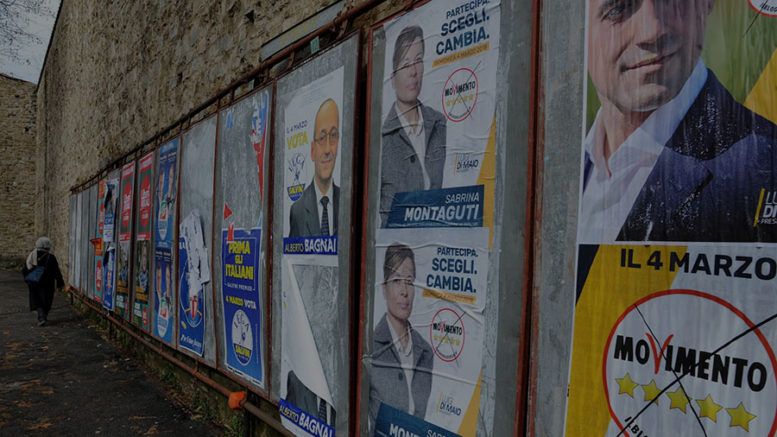Contributed from Victoria
Italy has effectively been without a government since an election on 4 March produced no clear result. Political parties have been jockeying to form work able coalitions that will bring together the numbers to get over the line.
But the political crisis is such that it has produced a stalemate. This is not merely about political parties unable to reach an agreement. The crisis cuts through Italian society. It’s the same story that is gripping other countries in Europe and further afield. People are sick and tired of the corrupt traditional parties and corrupt politicians.
Support for the traditional political parties, which in their latest manifestation made up the Democratic Party and the Berlusconi led Forza Italia, has haemorrhaged.
At the election, the anti-establishment party the Five Star Movement (M5S) topped the poll, and this was followed by Liga Nord, a party with a fascist tradition, although this part of it has been toned down in recent times.
Both have gained support, because they offer change to protect the average person, give them a voice and eradicate political corruption. Both favour leaving the European Union. There is also a vast difference between them. M5S is big on participatory democracy and social inclusion. The Liga is not, and its longer-term aim is to break the north away from Italy.
The Liga first emerged in Venice and has risen in what was formally the heartland of the Communist Party of Italy and known as the red belt. But as the party self-destructed, industries started to close, the livelihood of millions suffered, and as sense of being betrayed spread quickly. The Liga entered this vacuum, offering support for workers and promising to deal with greedy employers. They promised to defend social services. On the surface, it adopted many of what used to be the policies of the Communist Party, and by doing this, took a large part of the formerly communist support base.
There is also an anti-immigrant position. But where it finds purchase is in its identity with the region’s Celtic history and tradition and belief in writing a wrong of history since the invasion by thew Romans.
Meanwhile, a large part of the remaining communists, joined a section of their traditional rivals, the Christian democrats, and formed the Democratic Party, modeled on its American namesake. They became the government and were booted out in the last election. They had proved to be little different to the previous governments.
The Christian Democrats had also gone into dissolution, and in so doing, made room for Forza Italia. Italians, sick of the high-level corruption, turned against them too.
President, Sergio Mattarella, has proposed an appointed government of technocrats until next December, when a fresh election would be held. M5S and the Liga have poured cold water on this.
There is a standoff between the traditional ruling circles, still trying to hold on to their position, and the rising tide of those who feel the time is right to raise their counter voice. This is going to continue for the foreseeable future.
Italy, with the third largest economy in Europe, and one of the most vulnerable group of the continents economies known as the PIGS, the acronym for Portugal, Italy, Spain and Greece, is on the ropes. Official unemployment was sitting at around 11 percent at the end of last year. This is questionable, because the official employment rate is only 58.1 percent. And there has been a jump in part-time work. It is a similar story for youth unemployment, which officially stands at 31.7. Economic growth, the official rate again, is at the moment around one percent. Poverty has been rising and opportunities for a better life falling.
But it was the effort of the Mateo Renzi led Democratic Party government to change the constitution, that was the last straw, which led to a revolt. It went to a referendum at the end of 2016. Voters were asked to allow a change so that legislation would not have to pass the upper house, reducing the number of Senators by over two thirds.
Renzi had promised a shift away from austerity policies, to act on the plague of bank related and official corruption, marriage equality and a range of other issues. Few of the promises materialised, and the government looked like being increasingly locked into carrying on as usual.
When the reforms were raised, the public became concerned that they would be, used against their interests, to depress working conditions and quality of life in Italy would decline at an even faster rate. Many also felt that it would open the door to increasing autocratic government, and potentially, the return of fascism. The rise of M5S was the consequence.
For now, it looks like Italy will be headed for a new election as early as July.


If the people want to break off – let them. Maybe they need a few more choices – there’s too many mixed lolly bags here. Direct democracy may work, and autonomous regions – if people are that different in how they see themselves. What does Switzerland have to offer?